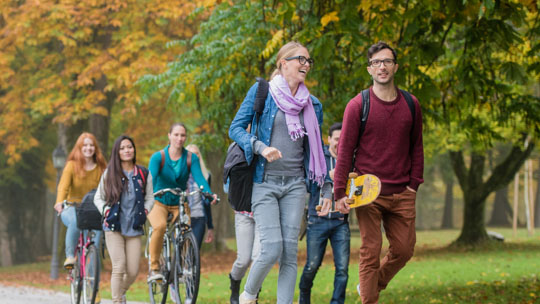When you think about Australia, your mind probably goes straight to Sydney, Uluru or kangaroos. Adelaide probably doesn't even crop up. Adelaide does seem to get a slightly bad rep for being kind of boring, but like anywhere else, a place is what you make it. Adelaide is where I spent my study abroad year and I LOVED it!
I decided to do a year abroad in my second year of uni. This all felt a little bit last minute and I was super stressed about choosing where to go. I wanted to go somewhere English-speaking so I wasn't limited by what courses I could do etc, and I didn't really want to go to the US (I was only 19 at the time so it would have been a bit rubbish). So, this left Australia. Which is somewhere I've always wanted to go, anyway. My uni was partnered with a few unis across Australia - I immediately set my heart on Melbourne. My home university is in Brighton (UK) and Melbourne seemed a lot like an Aussie version of that.
I put Adelaide down as my second choice but didn't really want to go there. But as Melbourne's too popular, I was sent to Adelaide, and I'm here to tell you why I'm so glad that that happened.
*Warning: this post is filled with ugly photos of me from my year abroad*
Here are some of the things I think are pretty neat about Adelaide:
It’s great value for money
That's not even the whole garden.
By Australian standards, anyway. As a student you are most likely broke 90 percent of the time, so you don't wanna live somewhere that will suck the life out of your bank account (I'm looking at you, Sydney). In Adelaide, you'll pay a fraction of the rent you would in Sydney and probably get a lot more for it. My rent was probably about AU$500-600 a month and I had huge room, and my house not only had a massive back garden but also a front garden AND parking space. I rented my house through Student Rooms who I highly recommend - they make it super easy, especially for international students. My garden had a large garage in it which, once spruced up, was perfect for parties (dinner and/or drinking)! I went to (and hosted) a lot of house parties in Adelaide, which are so much more fun than going out, especially in the heat.
It’s a very livable city
Australia is huge, which means it can be difficult to do anything without a car, but living in Adelaide you hardly even notice. The public transport is excellent - there are trams, trains, and buses to take you wherever you need to go. You can get a student Metrocard which allows you to travel at a discounted rate, or you can buy passes which allow you unlimited travel within a certain timeframe. Also, if you're in the city center, using the tram is free, which can make shopping a lot easier. It also helps that the city center isn't complicated, it's set out in a very structured, parallel manner and most of the important stuff is concentrated on about three main streets, making it difficult to get lost!
The Barossa Wine Valley
My wine glass was very empty.
The Barossa Wine Valley is world famous. If you buy a bottle of wine that says product of South Australia, this is probably where it comes from. Just about an hour outside of Adelaide. There are plenty of wine tours you can buy where you will be driven from winery to winery to get your fill of the winiest wine. Or, if have a really good friend who’s willing to be your designated driver, you can get very drunk on AU$5. Wine tasting is very fun, but I did learn the hard way that you are not allowed to pour your own glass of wine, that’s how you get in trouble.
Mad March
Face deep in a ball pit at an Exchange Student Network (ESN) cocktail party.
Some poor (or really good, you decide) planning means that almost everything big that is going to happen in Adelaide happens in one month - March. Mad March is host to the Adelaide Fringe Festival, WOMADelaide, Adelaide Festival, and Clipsal 500, among others. Despite the Fringe being on every year in my home uni city Brighton, I went for the first time in Adelaide and LOVED it. Myself and some friends went to see Briefs - I highly recommend them!
This is all not to say there isn't other stuff going on throughout the year - there are festivals and events happening all year round. You could catch a performance at the historic Thebarton Theatre - there are plenty of big names playing in Adelaide. Or you could enjoy your first game of Australian football - in Adelaide, you obviously have to support the Crows. The University Union (I attended the University of Adelaide not the University of South Australia, so I can't speak for them, but I'm sure it's similar) and the Exchange Student Network (ESN) were very good at organizing events all year round. These events were perfect for making new friends and getting to know the city - so make good use of these!
The Central Market
The Central Market dates back to 1869 and is one of the best sources of fresh and wholesome food in Adelaide. There’s an assortment of stalls that sell amazing veggie food and foods from different cultures. This is as well as the obligatory fruit and veg stalls, there are cheeses, nuts, sweets, and fabrics! It is a great place to do your food shop if you’re trying to cut down on your plastic footprint.
Pro tip: On a Saturday afternoon literally everything is AU$1 or less, as the market is closed Sunday and Monday - so everything must go!
Rundle Mall
Almost everything is on one street, which some may see as a bad thing, but I like it, it makes life easy. That street is called Rundle Mall. Rundle Mall has all your favorite Australian brands that you've probably never heard of, and also some that you might have i.e. Target. This mall is also home to some balls - Malls Balls. These balls are nationally famous and are super shiny which is great for selfie taking. You also are almost guaranteed to encounter a man playing several instruments, the most of important of which is of course the iconic didgeridoo.
It has top notch beaches
Australia is notorious for beautiful beaches, and Adelaide is no exception. I lived a 20-minute bus journey from my closest white sand beach. This was amazing in the Spring and Autumn as once you've finished uni you can nip to the beach for a quick dip in the sea. In the summer, you'll probably be enjoying beaches elsewhere in Australasia and the winter isn't exactly ideal for swimming (unless you're into that kind of thing).
Adelaide Hills
I lost a shoe to this waterbody. RIP.
Adelaide is surrounded by hills which make for some beautiful scenery and some lovely drives. Up in the hills, is a little German village called Hahndorf. The village is filled with boutique stores, historic buildings, art, and loads of good food. And, the year I was there it even actually snowed in Hahndorf (only a little, for like a day, but it still happened)!
There are probably loads of cool things to do up in them there hills, but one of my favorite things was going swimming in Highbury Quarry. This is a big ol' disused quarry that has filled with water. The water is crystal clear blue probably owing to the high levels of leachates and being highly polluted. Pretty as heck, though! Now, I DO NOT encourage trespassing, but what people choose to do in their own time is up to them.
Adelaideans have a unique accent (apparently)
I won't lie, they all sound Australian to me. BUT if you want a slightly different sounding Aussie, then Adelaide is the place for you! Most Aussies pronounce words in an 'American' way, whereas people from South Australia (Adelaide) pronounce them in a more 'British' way.
Adelaide has actual seasons
Now of course everywhere has seasons, but what I mean is that it actually gets almost cold in Adelaide. You may think this is a bad thing, but it was the main reason I chose somewhere in the South of Australia. Seasons are a blessing if, like me, you’re accustomed to the cold. It can get up to 40°C in the summer and down to around 5°C in the winter. Don't get me wrong, I love the sun and the heat but there is only so much this pasty white girl can take.
It's the City of Churches
When you do a generic internet search for Adelaide you will find out that it is the 'City of Churches'. I'm not really sure why this is - the people who built Adelaide just really like churches, I guess. The oldest church in Adelaide is the Holy Trinity Anglican Church at 200 years old! Now, personally, a church isn't something I get excited about (although I do love the architecture) but if you're a real church-head, then Adelaide is calling you!
The universities
There three main universities in Adelaide – the University of Adelaide, the University of South Australia (UniSA), and Flinders University. I went to Adelaide Uni and thoroughly enjoyed it. I studied Ecology, which was taught super well and meant I got to go on field trips. These were great as I got to make friends that were Australian, and not just more international students (not that they're not great)! I also took some anthropology courses during my program and found out that I'm actually quite good at it.
Adelaide University is good for more sciencey maths kinda stuff. The University of South Australia is generally better for nursing, arts, and social sciences. Flinders University is best suited to medicine and dietetics, due to its proximity to the hospital. There are talks of a merger of UniSA and Adelaide to form one super-university, so watch this space…
--
Now, my opinion is very biased I know, because I had the best year and I can't wait to go back. But you should choose to go to Adelaide, it's not like you won't see the rest of Australia when you travel. I believe you get a better experience when you live somewhere where you can actually afford to have fun! I made some amazing friends, which was easy to do as everyone is so nice. Eventually, I want to move back to Australia, and I will be heading straight for Adelaide!
*Be warned though, by living in Australia you will become one of them - you will start doing things like saying 'hey' at the end of every sentence or believing that 30°C isn't really that hot. But the sacrifices we make, hey?* And don’t get me started on their weird slang.
So, in conclusion, Adelaide is 10/10 - definitely would recommend to a friend.



